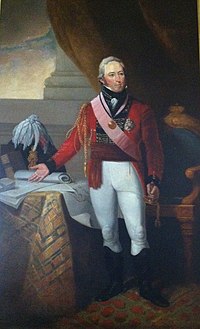Battle of Hampden
| Battle of Hampden | |||||||
|---|---|---|---|---|---|---|---|
| Part of the War of 1812 | |||||||
 Sir John Coape Sherbrooke by Robert Field, (The Halifax Club) |
|||||||
|
|||||||
| Belligerents | |||||||
|
|
|
||||||
| Commanders and leaders | |||||||
|
Robert Barrie John Coape Sherbrooke |
Charles Morris | ||||||
| Strength | |||||||
| 3 warships 2 support ships 750 |
1 warship 725 |
||||||
| Casualties and losses | |||||||
| 2 killed 8 wounded 1 missing |
1 killed 11 wounded prisoners 70 captured 1 frigate scuttled |
||||||
The Battle of Hampden was an action in the British campaign to conquer present-day Maine and remake it into the colony of New Ireland during the War of 1812. Sir John Sherbrooke led a British force from Halifax, Nova Scotia to establish New Ireland, which lasted until the end of the war, eight months later. The brief life of the colony yielded customs revenues which were subsequently used to finance a military library in Halifax and found Dalhousie College.
The subsequent retirement of the British expeditionary force from its base in Castine to Nova Scotia ensured that eastern Maine would remain a part of the United States. Lingering local feelings of vulnerability, however, would help fuel the post-war movement for statehood for Maine. The withdrawal of the British after the ratification of the Treaty of Ghent represented the end of two centuries of violent contest over Maine by rival nations (initially the French and British, and then the British and Americans).
On August 26, 1814, a British squadron from the Royal Navy base at Halifax moved to capture the Down East coastal town of Machias. The force consisted of five warships: HMS Dragon (74), HMS Endymion (40), HMS Bacchante (38), HMS Sylph (18), a large tender, and ten transports carrying some 3,000 British regulars (elements of the 29th, 60th, 62nd, and 98th regiments and a company of Royal Artillery).
The expedition was under the overall command of Sir John Sherbrooke, who was then the lieutenant governor of Nova Scotia. Major General Gerard Gosselin commanded the army and Rear Admiral Edward Griffith Colpoys controlled the naval elements.
...
Wikipedia
